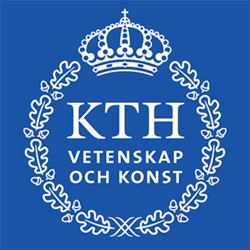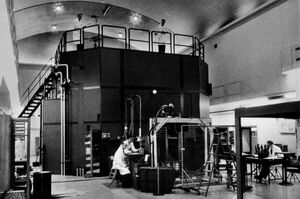Difference between revisions of "KTH Royal Institute of Technology"
(unstub) |
|||
| Line 3: | Line 3: | ||
|website= | |website= | ||
|constitutes=university | |constitutes=university | ||
| + | |type=public,research | ||
|leaders= | |leaders= | ||
|logo=Logotype_of_KTH_Royal_Institute_of_Technology.png | |logo=Logotype_of_KTH_Royal_Institute_of_Technology.png | ||
|start=1827 | |start=1827 | ||
|headquarters=Stockholm, Sweden | |headquarters=Stockholm, Sweden | ||
| + | |description=The highest ranked technical university in [[Sweden]]. | ||
}} | }} | ||
| + | '''KTH Royal Institute of Technology''' is a [[Public university|public]] [[research university]] in [[Stockholm]], [[Sweden]]. KTH conducts research and education within [[Institute of technology|engineering and technology]], and is Sweden's largest technical university.<ref>https://www.kth.se/en/om/fakta/sveriges-storsta-tekniska-universitet-1.3487</ref> Currently, KTH consists of five [[#Schools|schools]] with four [[#Campuses|campuses]] in and around Stockholm. | ||
| + | |||
| + | KTH was established in 1827 as ''Teknologiska Institutet (Institute of Technology),'' and had its roots in ''Mekaniska skolan (School of Mechanics)'' that was established in 1798 in Stockholm. But the origin of KTH dates back to the predecessor to ''Mekaniska skolan,'' the ''Laboratorium Mechanicum,'' which was established in 1697 by Swedish scientist and innovator [[Christopher Polhem]]. Laboratorium Mechanicum combined education technology, a laboratory and an exhibition space for innovations.<ref>Lindgren, Michael, 1953- (2011). Christopher Polhems testamente : berättelsen om ingenjören, entreprenören och pedagogen som ville förändra Sverige. Stockholm: Innovationshistoria Förlag.</ref> In 1877 KTH received its current name, Kungliga Tekniska högskolan (KTH Royal Institute of Technology). The King of Sweden | ||
| + | |||
| + | KTH is the highest ranked technical university in Sweden. | ||
| + | |||
| + | ===R1 nuclear reactor=== | ||
| + | [[File:R1 KTH.jpg|thumb|The R1 nuclear reactor.]] | ||
| + | After the American deployment of nuclear weapons at the end of [[World War II]], the Swedish military leadership recognized the need for [[nuclear weapons]] to be thoroughly investigated and researched to provide Sweden with the knowledge to defend itself from a nuclear attack. With the mission to "make something with neutrons", the Swedish team, with scientists like [[Rolf Maximilian Sievert]], set out to research the subject and eventually build a [[nuclear reactor]] for testing. | ||
| + | |||
| + | After a few years of basic research, they started building a 300 kW (later expanded to 1 MW) reactor, named ''Reaktor 1'' (''R1''), in a reactor hall 25 meters under the surface right underneath KTH. Today this might seem ill-considered, since approximately 40,000 people lived within a 1 km radius. It was risky, but was deemed tolerable since the reactor was an important research tool for scientists at the [[Royal Swedish Academy of Engineering Sciences]] (''Ingenjörsvetenskapsakademien''). | ||
| + | |||
| + | At 18:59 on 13 July 1954, the reactor reached [[Critical mass (nuclear)|critical mass]] and sustained Sweden's first nuclear reaction. R1 was to be the main site for almost all Swedish nuclear research until 1970 when the reactor was finally decommissioned, mostly due to the increased awareness of the risks associated with operating a reactor in a densely populated area of [[Stockholm]]. | ||
| + | |||
{{SMWDocs}} | {{SMWDocs}} | ||
==References== | ==References== | ||
{{reflist}} | {{reflist}} | ||
| − | |||
Latest revision as of 11:30, 2 April 2021
(University) | |
|---|---|
 | |
| Formation | 1827 |
| Headquarters | Stockholm, Sweden |
| Type | • public • research |
| The highest ranked technical university in Sweden. | |
KTH Royal Institute of Technology is a public research university in Stockholm, Sweden. KTH conducts research and education within engineering and technology, and is Sweden's largest technical university.[1] Currently, KTH consists of five schools with four campuses in and around Stockholm.
KTH was established in 1827 as Teknologiska Institutet (Institute of Technology), and had its roots in Mekaniska skolan (School of Mechanics) that was established in 1798 in Stockholm. But the origin of KTH dates back to the predecessor to Mekaniska skolan, the Laboratorium Mechanicum, which was established in 1697 by Swedish scientist and innovator Christopher Polhem. Laboratorium Mechanicum combined education technology, a laboratory and an exhibition space for innovations.[2] In 1877 KTH received its current name, Kungliga Tekniska högskolan (KTH Royal Institute of Technology). The King of Sweden
KTH is the highest ranked technical university in Sweden.
R1 nuclear reactor
After the American deployment of nuclear weapons at the end of World War II, the Swedish military leadership recognized the need for nuclear weapons to be thoroughly investigated and researched to provide Sweden with the knowledge to defend itself from a nuclear attack. With the mission to "make something with neutrons", the Swedish team, with scientists like Rolf Maximilian Sievert, set out to research the subject and eventually build a nuclear reactor for testing.
After a few years of basic research, they started building a 300 kW (later expanded to 1 MW) reactor, named Reaktor 1 (R1), in a reactor hall 25 meters under the surface right underneath KTH. Today this might seem ill-considered, since approximately 40,000 people lived within a 1 km radius. It was risky, but was deemed tolerable since the reactor was an important research tool for scientists at the Royal Swedish Academy of Engineering Sciences (Ingenjörsvetenskapsakademien).
At 18:59 on 13 July 1954, the reactor reached critical mass and sustained Sweden's first nuclear reaction. R1 was to be the main site for almost all Swedish nuclear research until 1970 when the reactor was finally decommissioned, mostly due to the increased awareness of the risks associated with operating a reactor in a densely populated area of Stockholm.
Employee on Wikispooks
| Employee | Job | Appointed | Description |
|---|---|---|---|
| Danica Kragić | Head of the Center for Autonomous Systems | 2008 | Bilderberg 2018 |
Alumni on Wikispooks
| Person | Born | Died | Nationality | Summary | Description |
|---|---|---|---|---|---|
| Börje Ekholm | 1963 | Sweden US | Deep state functionary Businessperson | Wallenberg Sphere businessman, succeeded fellow Bilderberger Marcus Wallenberg as CEO of Investor AB. Then CEO of Ericsson. | |
| Johan Eliasch | February 1962 | Sweden UK | Businessperson | Swedish-British businessman with a heavy WEF/Annual Meeting habit. Named in Epstein's Black book. | |
| Danica Kragić | 10 August 1971 | Sweden | Academic | Single Bilderberg robotics researcher. Wallenberg Sphere. | |
| Adolf Lundin | 19 December 1932 | 30 September 2006 | Sweden | Deep state operative Businessperson | Swedish oil and mining entrepreneur, and ardent anti-communist. Brother of powerful spook leader Bertil Lundin. |
| Björn Lundvall | 12 August 1920 | 14 September 1980 | Sweden | Businessperson | As CEO of LM Ericsson, a part of the Wallenberg Sphere, Lundvall also represented the Wallenberg family as a member of the Bilderberg Steering committee. |
| Curt Nicolin | 10 March 1921 | 8 September 2006 | Sweden | Businessperson | Swedish businessman. A part of the Wallenberg Sphere, he was chairman of ASEA and the Swedish Employers Association, and attended the 1984 Bilderberg meeting. |
| Oscar Stenström | 1975 | Sweden | Civil servant Deep state operative | Swedish civil servant who negotiated the Swedish accession to NATO. Went to his first Bilderberg in 2023. | |
| Björn Svedberg | 4 July 1937 | Sweden | Engineer Deep state operative Businessperson | Swedish company director and part of the Wallenberg Sphere | |
| Hans Werthén | 15 June 1919 | January 2000 | Sweden | Businessperson | Swedish business executive who attended Bilderberg/1983 and Bilderberg/1984 as Chairman of Electrolux and Ericsson. Wallenberg sphere. |
References
- ↑ https://www.kth.se/en/om/fakta/sveriges-storsta-tekniska-universitet-1.3487
- ↑ Lindgren, Michael, 1953- (2011). Christopher Polhems testamente : berättelsen om ingenjören, entreprenören och pedagogen som ville förändra Sverige. Stockholm: Innovationshistoria Förlag.
